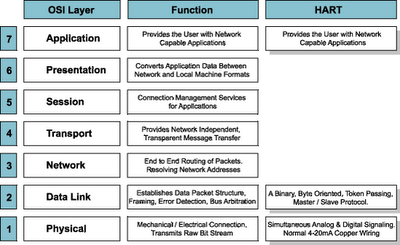The HART Protocol is the leading communication technology used with smart process instrumentation today. The HART Protocol continues to grow in popularity and recognition in the industry as a global standard for smart instrument communication. More than two-thirds of all smart instruments shipping today communicate using the HART Protocol.
EASY TO USE
HART is field-proven, easy to use and provides highly capable two-way digital communication simultaneously with the 4-20mA analog signaling used by traditional instrumentation equipment.
UNIQUE COMMUNICATION SOLUTION
Unlike other digital communication technologies, the HART Protocol provides a unique communication solution that is backward compatible with the installed base of instrumentation in use today. This backward compatibility ensures that investments in existing cabling and current control strategies will remain secure well into the future.
Designed to compliment traditional 4-20mA analog signaling, the HART Protocol supports two way digital communications for process measurement and control devices. Applications include remote process variable interrogation, cyclical access to process data, parameter setting and diagnostics.
STRUCTURE
Specification of the HART protocol is based largely on the OSI 7-Layer Communication Model (see Figure 1).

Figure 1. OSI 7-Layer Model
The HART protocol specifications directly address 3 layers in the OSI model: the Physical, Data Link and Application Layers. The Physical Layer connects devices together and communicates a bit-stream from one device to another. It is concerned with the mechanical and electrical properties of the connection and the medium (the copper wire cable) connecting the devices. Signal characteristics are defined to achieve a raw uncorrected reliability (see the FSK Physical Layer Specification).
While the Physical Layer transmits the bit stream, the Data Link Layer is responsible for reliably transferring that data across the channel. It organizes the raw bit stream into packets (framing), adds error detection codes to the data stream and performs Media Access Control (MAC) to insure orderly access to the communication channel by both master and slave devices.
The bit stream is organized into 8-bit bytes that are further grouped into messages. A HART transaction consists of a master command and a slave response. Media access consists of token passing between the devices connected to the channel. The passing of the token is implied by the actual message transmitted. Timers are used to bound the period between transactions. Once the timer expires, control of the channel is relinquished by the owner of the token. For more information see the Data Link Layer Specification.
The Application Layer defines the commands, responses, data types and status reporting supported by the Protocol. In addition, there are certain conventions in HART (for example how to trim the loop current) that are also considered part of the Application Layer. While the Command Summary, Common Tables and Command Response Code Specifications all establish mandatory Application Layer practices (e.g. data types, common definitions of data items, and procedures), the Universal Commands specify the minimum Application Layer content of all HART compatible devices.
No comments:
Post a Comment